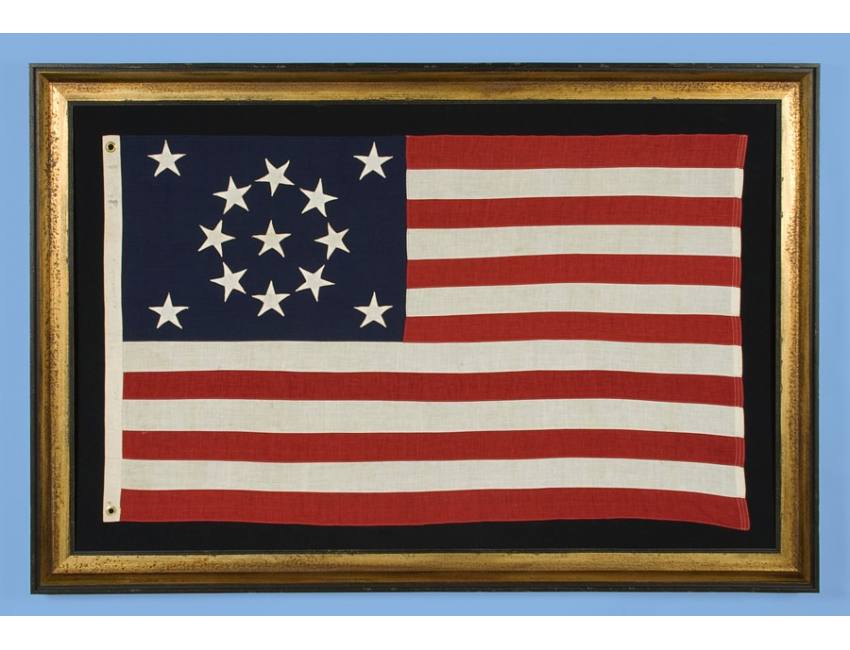|

|
Description: |
|
Starting around the year 1890, flag-makers started to produce small-scale flags for use on private yachts. These typically measured between three and four feet in length and, with but a few exceptions, had one of two varieties of star patterns: either rows of 3-2-3-2-3 (comprising about 75% of the total) or a circular wreath of 8 stars with a star in the center and a flanking star outside it in each corner (the remaining 25%). Because these flags were made for boats, they were constructed of wool bunting with cotton stars and a hoist made of either canvas or heavy cotton twill. Wool sheds water, which made it the choice of all commercial flag-makers who produced them for nautical use during the 18th and 19th centuries. Starting around the 1920’s, however, commercial flag-makers began to introduce cotton and synthetic fabrics into such flags because wool was subject to moth damage and flag-makers desired to reduce the problems associated with it while flags were in storage.
While these three and four-foot flags were produced primarily for maritime use, they could be bought for any reason and I have sometimes encountered them in early photographs being flown on land for general patriotic use. As the nation’s 150-year anniversary of independence approached, the use of these yacht ensigns with 13 stars basically came to an end. There was a variety that continued to be flown, with a wreath of 13 stars surrounding an anchor, and that design is still in use today by owners of private boats and yachts. But the plain 13 star flags with 3-2-3-2-3 patterns and the medallion pattern seen on this flag basically disappeared. It seems likely that the last year that they were produced in great numbers fell around 1926, when production probably increased so that such flags could be sold in celebration of the sesquicentennial and its associated celebrations. Under this presumption, one might expect to see some cotton flags made with this medallion pattern that was so popular on private boats. But that really isn’t the case. And this is why this particular medallion pattern 13 star flag is so unusual among the hundreds of 13 star flags I have seen that date to the late 19th and early 20th centuries.
The measurements of this flag mimic the two-and-a-half by four-foot variety of private yacht ensigns, instead of being constructed of wool bunting, it is made entirely of lightweight cotton. It is entirely machine-sewn, like almost all private boat flags of this era, yet its stars are appliquéd with a lineal stitch, instead of the zigzag stitch, patented in 1892, which was used on most private boat ensigns, especially later ones. There are two brass grommets along the hoist, along with a stencil that reads: “2 ½ x 4” and a penciled signature that reads either “Tennant” or “Tennaut”. During the late 19th and early 20th centuries it was common to mark a flag in this fashion to indicate ownership.
The colors of the flag are striking, as-is the overall presentation. This is a particularly nice rendition of the medallion pattern, which varied from one example to the next. Note how the stars are particularly pointy, which adds to its visual qualities. The small size the flag is also significant, because unlike most flags with sewn construction that were made during this era, which were often at least 6 to 12 feet in length, the small size of private boat ensigns makes them easy to frame and display in a modern indoor setting.
13 star flags have been used throughout our Nation's history for a variety of purposes. In addition to their use at the sesquicentennial and on private yachts, the U.S. Navy used the 13 star count on small boats, both in the 18th century and through most or all of the 19th century, particularly the second half. The practice ended in 1916 following an executive order of President Woodrow Wilson. Some private ships also used 13 star flags during the same period as the Navy, and the use of yachting ensigns with a wreath of 13 stars surrounding an anchor, which began in 1848, still persists today. Among other uses, 13 star flags were carried by soldiers during the Mexican and Civil Wars, and were used at patriotic events, including Lafayette’s visit in 1825-26 and the celebration of the Nation’s Centennial in 1876.
Mounting: The flag has been stitched to 100% silk organza on every seam and throughout the star field for support. Then flag was then hand-sewn to background of 100% cotton twill, black in color, which was washed to reduce excess dye. An acid-free agent was added to the wash to further set the dye and the fabric was heat-treated for the same purpose. The flag was then placed in a black-painted and hand-gilded, contemporary Italian molding. The front is u.v. protective acrylic. |
| Inventory Number: |
|
|
|
Dealer |
Jeff R. Bridgman American Antiques, llc |
| Contact |
Jeff Bridgman |
Phone: (717) 502-1281 |
|
| Period: |
1st Half 20th Century (1901 -1949) |
|
| Date: |
1920-1926 |
|
| Origin: |
US |
|
| Condition: |
Excellent. There are no serious condition issues. |
|
| Measurements: |
Flag: 30.75" x 50" Frame: 42.25" x 61.25" |
|
| Inventory |
Other Inventory by this Dealer |
|
| Web-site: |
http://www.jeffbridgman.com |
|
| Price: |
Sold |
|
| E-mail: |
Inquire
|
|
Click thumbnail
to view larger
|
